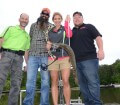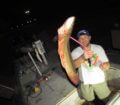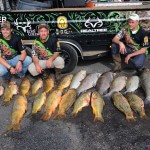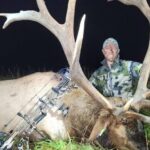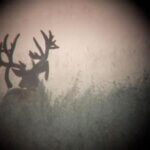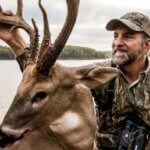John’s Note: Chuck Belmore, the winner of the 2011 World Bowfishing Championship, is another bowfisherman who’s turned his love of bowfishing into his job. He’s the host of The Habit TV on the Sportsman Channel on Sunday nights and Mondays at 4:00 pm.
My Tips for Successful Bowfishing include:
 1) Always shoot low when aiming at fish.
1) Always shoot low when aiming at fish.
2) Have quality equipment.
3) Practice in the backyard to learn to bowfish – much like learning to play baseball. Practice shooting instinctively. If you’re throwing a baseball, you’ll usually start practicing in the backyard throwing at the catcher’s mitt. You don’t aim at the catcher’s mitt – you just throw. And, the more you throw, the more times you’ll hit the catcher’s mitt in its center. An archer has to practice instinctively, and the more you practice, the better you get, and the more times you’ll hit fish. I take the barbs off my fishing arrow and shoot it in the backyard into the ground. I also shoot bottle caps, small shells and any kind of target out to about 20 feet. Many guys when they’re practicing for bowfishing will stand on a small step stool and shoot at targets on the ground, to familiarize themselves with shooting off a boat.
 4) Learn to read the water conditions. Bass fisherman know where to look for fish when the water’s muddy, clear, a current’s coming through the lake, a full moon’s out and no moon, and bowfishermen must learn these same skills. Each lake is different, and different fish react in various ways to weather and water conditions. For instance at Lake Guntersville, when current starts coming through the lake, the rough fish will move out to deeper water. These rough fish may come up just under the surface in deep water, especially at night. If the water heats-up in the daytime, fish will move into deep water at night. If the air temperature drops down, the fish will move to deeper water. In muddy water, the fish seem to be much more skittish and more sensitive to vibrations in the boat, which means you have to be still and quiet in the boat. In clear water, the fish will be somewhat deeper in stained water and less sensitive to boat noise. Too, the fish will be holding further off the bank. When the wind blows, the water close to the bank will muddy-up and seeing fish within bow range becomes much more difficult. So, when you’re scouting, try to locate places where you can take fish in different wind conditions and wind directions. For instance, if a bowfishing competition is held on Saturday night, and the wind is from the south, you want to fish from the south side of the lake.
4) Learn to read the water conditions. Bass fisherman know where to look for fish when the water’s muddy, clear, a current’s coming through the lake, a full moon’s out and no moon, and bowfishermen must learn these same skills. Each lake is different, and different fish react in various ways to weather and water conditions. For instance at Lake Guntersville, when current starts coming through the lake, the rough fish will move out to deeper water. These rough fish may come up just under the surface in deep water, especially at night. If the water heats-up in the daytime, fish will move into deep water at night. If the air temperature drops down, the fish will move to deeper water. In muddy water, the fish seem to be much more skittish and more sensitive to vibrations in the boat, which means you have to be still and quiet in the boat. In clear water, the fish will be somewhat deeper in stained water and less sensitive to boat noise. Too, the fish will be holding further off the bank. When the wind blows, the water close to the bank will muddy-up and seeing fish within bow range becomes much more difficult. So, when you’re scouting, try to locate places where you can take fish in different wind conditions and wind directions. For instance, if a bowfishing competition is held on Saturday night, and the wind is from the south, you want to fish from the south side of the lake.
5) Consider moon phase. I don’t worry too much about moon phase, except on nights with a full moon. Historically I’ve found fewer fish then. I prefer to bowfish on a dark night with little or no moon.
 6) Scout the lake. When we’re planning to compete in a big bowfishing tournament like the Muzzy Bowfishing Classic, we’ll come to the lake the weekend before the tournament and scout for several days. Before the tournament on a weekend, we’ll try to scout Wednesday-Friday nights that week.
6) Scout the lake. When we’re planning to compete in a big bowfishing tournament like the Muzzy Bowfishing Classic, we’ll come to the lake the weekend before the tournament and scout for several days. Before the tournament on a weekend, we’ll try to scout Wednesday-Friday nights that week.
7) Set-up a game plan to win a bowfishing tournament. For instance, to compete in the Muzzy Classic on Lake Guntersville, we wanted to take 15 big common carp and five buffalo. I’d plan to start the night looking on the edges of grass beds for common carp, because in April during the Muzzy Classic the common carp would be spawning. I’d try in the backs of the coves where the carp generally would be feeding on a soft bottom. We’d get a topographical map and look where the bottom changes depths. When we spotted fish while scouting at night, we’d mark those locations on our map or depth finder, return the next day and see what type of grass was there, and in what water depth the fish was. Then we’d go to the same kind of bank and search for fish with the same wind direction.
The best pattern we ever put together was in Louisiana where we won the World Bowfishing Championship. Butch Sampson, Clint Ivey and I were partners and pinpointed fish in 3-5 foot deep ponds with a west wind blowing. Each pond had a channel coming in and running through it. The brackish water ponds had crabs in them and also held big catfish, with our biggest 69 pounds. We could have 15 fish of one kind, and we bet on catfish for our 15. We only were permitted to take five big alligator gar, which we did for a total of catfish and gar weighing 882 pounds.
To learn more about bowfishing, go to our series of videos called, “Bowfishing 101.”
To get John’s latest cookbooks, “The Crappie Catcher’s Cookbook” and “The Catfish Catcher’s Cookbook” for free, click here. To see all of John’s available print and eBooks, click here.

